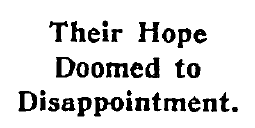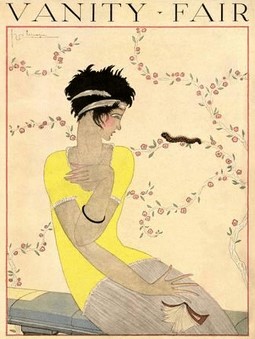I’m not in much of a mood to wax philosophical, having recently made my second trip from Cape Town to Washington, D.C. in two months. So I’ll just say that I feel really, really sorry for all those people out there who aren’t spending the year reading as if they were living in 1918. Check out these bests and worsts of June and July to see why.
Best Magazine: The American Journal of Insanity
The American Journal of Insanity is so good that its name isn’t even the best thing about it. It’s full of case histories of various psychological conditions that read like novels.* The saddest is the story, in an article titled “The Insane Psychoneurotic,” of a Romanian Jewish immigrant who studied to become a lawyer while working (like Marcus Eli Ravage and every other Romanian Jewish immigrant) in a Lower East Side textile factory. He fell into a depression after failing the bar exam three times, became elated when he passed on his fourth try, and then went blind. A doctor restored his sight by pressing a pencil against his eye and telling him that he would be able to see when he opened his eyes. He lost the ability to talk and recovered it when a woman volunteer agreed to his (written) request that she allow him to use her first name. He was institutionalized for a while and released to outpatient care when he seemed to be getting better. Twelve days after his release, though, he hanged himself.
There’s also an article on shell shock by a French doctor that deals in a sympathetic and nuanced manner with the often-dismissed condition, and that in no way justifies the discussion of his and his colleagues’ research in the New York Times under this headline:**
Before awarding it the prestigious “Best Magazine” title, I figured I should check whether The American Journal of Insanity, like many other erstwhile subjects of my 1918 admiration (I’m looking at you, Marie Carmichael Stopes!), was a fan of eugenics, and in particular of the forced sterilization of “defectives.” So I did a word search of the 1918-1919 volume, cheated a little to glance at the 1919 article that came up, and found out that they were absolutely appalled by it. Way to go, AJI!
Best quote from a book in a review:
“They had a child which they named Joseph and dearly loved, as was then the fashion among parents in all that region.” (From the Ambrose Bierce short story “A Baby Tramp” (1893), quoted in a retrospective on Bierce in The Dial, July 18, 1918.)
Worst Editorial: “Their Hope Doomed to Disappointment,” New York Times, July 27, 1918
A German newspaper has, according to a July 27 Times editorial, proposed that the German army undermine morale among American prisoners of war by making black and white soldiers live together in close quarters.
This, the deviser of the scheme thinks, would give keenest pain both to those thus united in misfortune and to Americans in general…His basis of belief is some vague knowledge he has of the negro’s place in the United States and an exaggerated and distorted notion of an antagonism existing here between the white and black races.
Which, the Times says, is totally not the case!***
Someone should tell the German editor that negroes are not hated in this country—that in innumerable white families they occupy positions that bring them into daily and intimate contact with the other members, especially the children, and it is the Americans who know the negro best that in proper place and season are most forgetful of racial differences or make most kindly allowance for them.
Really, you can’t make this stuff up.
Best Ad:
I wish I could honor a more healthy product, but Murad owns this category.
Worst Ad:
…Although not all Murad ads are created equal. This one looks like their regular artist was off sick so they hired a failed Italian Futurist as a temp.
Best Magazine Covers:
I love this Georges Lepape portrait of a short-haired, drop-waisted proto-flapper.
My favorite thing about this Erté Harper’s Bazar cover, called “Surprises of the Sea,” is the octopus eye.
On to August!
*Although they don’t seem, at this point in the history of psychiatry, to ever actually cure anyone. Which could explain why the case histories read like novels.
**Which first came to my attention as a “Whatever It Is, I’m Against It” Headline of the Day.
***Even though the very same issue has an article and an editorial about lynching.









AJI, indeed! There’s a lot to love about this 1918 magazine! I hardly know where to start. “In proper place and season” would set the tone for alleged American hypocrisy in white-black relationships. “Whatever it is, I’m against it” kind of rolls off the tongue, esp. as the lead-in for an editorial about lynching. Erté is always a rare treat. I believe this is my first octopus eye, however, and the Harper’s Bazar cover looks a bit, well, bizarre with the missing “a.” But I’m glad that stylish parents made a point of being affectionate with their young — a novel idea. Oh, and the weirdly named Murad cigarettes from Turkey did inspire a vibrant ad. According to my extensive research (Concise Columbia Encyclopedia), Dr. Freud himself would have been 62 in 1918. Perhaps he was a subscriber, or even a writer of articles about his hysteria theories. His daughter, Anna Freud, would no doubt be busy treating traumatized children today — those left behind by their deported parents. I guess that’s the thing about insanity; it never goes out of style.
LikeLike
I hardly knew where to go with this, either. Especially the NYT editorial, which also contains this gem: “Companions in misery would not be troubled by the spectre of ‘social equality,’ and there would be no lack of respect on the part of white men for black men who had fought as well and as bravely as themselves against the common enemy of both.” Although of course the Times isn’t advocating anything crazy like desegregated military units. The Journal of Insanity also included the story of an English elevator who had, among other problems, a lack of sexual desire, so that his mother-in-law regarded him as a “regular sissy.”
It’s interesting to see how Freud was treated in the U.S. in 1918. He was in Vienna (with sons in the military) and his communication with Allied countries was limited. Also people were reluctant to express admiration for nationals of enemy countries. (Even Jewish ones, unlike in WWII.) But Freud was such a dominant figure that he couldn’t be ignored. Basically he was treated as if he were dead, with people talking about his influence as opposed to him as a current figure in the field.
Yeah, that’s how Harper’s Bazar was spelled until 1929. When I was looking that up I discovered that it was a Hearst publication, which I hadn’t realized.
LikeLike
You find the most fascinating stuff!
Myself, I’m living the world just before 1918 this past week as I use Mina Loy as a pointer and start looking at the Greenwich Village Provincetown playhouse scene in my much less industrious reading. Not sure if any of it will be usable for my purposes, but this stuff pulls you in.
The Murad ads (besides, well, cancer sticks, and yes, fascinating graphics design) have one other oddity. From looking at this gallery:
http://tobacco.stanford.edu/tobacco_main/images.php?token2=fm_st210.php&token1=fm_img6285.php&theme_file=fm_mt027.php&theme_name=Early%20Orientalist&subtheme_name=Murad
It appears that in the prewar years the brand referred to Egyptian and Turkish Tobacco prominently, but by the US WWI era it had become “The Turkish Cigarette” and a post war ad talks about going “6000 miles to the provinces about the Black Sea for the finest, costliest varieties of Turkish tobacco.” Wasn’t the Ottoman Empire part of the Central Powers? And German associated stuff certainly suffered in the US during WWI. It’s a US brand, (and I thought tobacco was native to the Americas anyway, so how could it be like American wine from European grape varieties sort of Turkish tobacco). If nothing else, what a logistical supply issue if they really used tobacco from the Ottoman Empire during the war years.
I’m guessing marketing B. S.–but even then you couldn’t imagine the guys at Gallipoli heartily endorsing “The Turkish Cigarette”–advertising exoticism be damned.
LikeLiked by 1 person
I’ve gotten behind on commenting on your blog due to lots of traveling, but I’ve enjoyed your recent posts, including the Mina Loy one. Will be in touch there!
Jeremy McCarter’s very readable Young Radicals, which I read last year in preparation for this project, had a lot on the playhouse scene and especially John Reed’s role in it.
Thanks for the fascinating info on Murads! I commented early in the year on the oddness of the popularity of so-called Turkish cigarettes despite Turkey being allied with the Germans (https://myyearin1918.com/2018/01/24/wednesday-miscellany-oh-and-by-the-way-were-publishing-ulysses/). It’s especially strange given that much of the advertising was specifically tied to the war. “After the smoke of battle–the most refreshing smoke is Murad!” (Which is odd even beyond the Turkish connection: “After inhaling toxic smoke while fighting, what could be more refreshing than filling your lungs with more toxic smoke?”
LikeLike